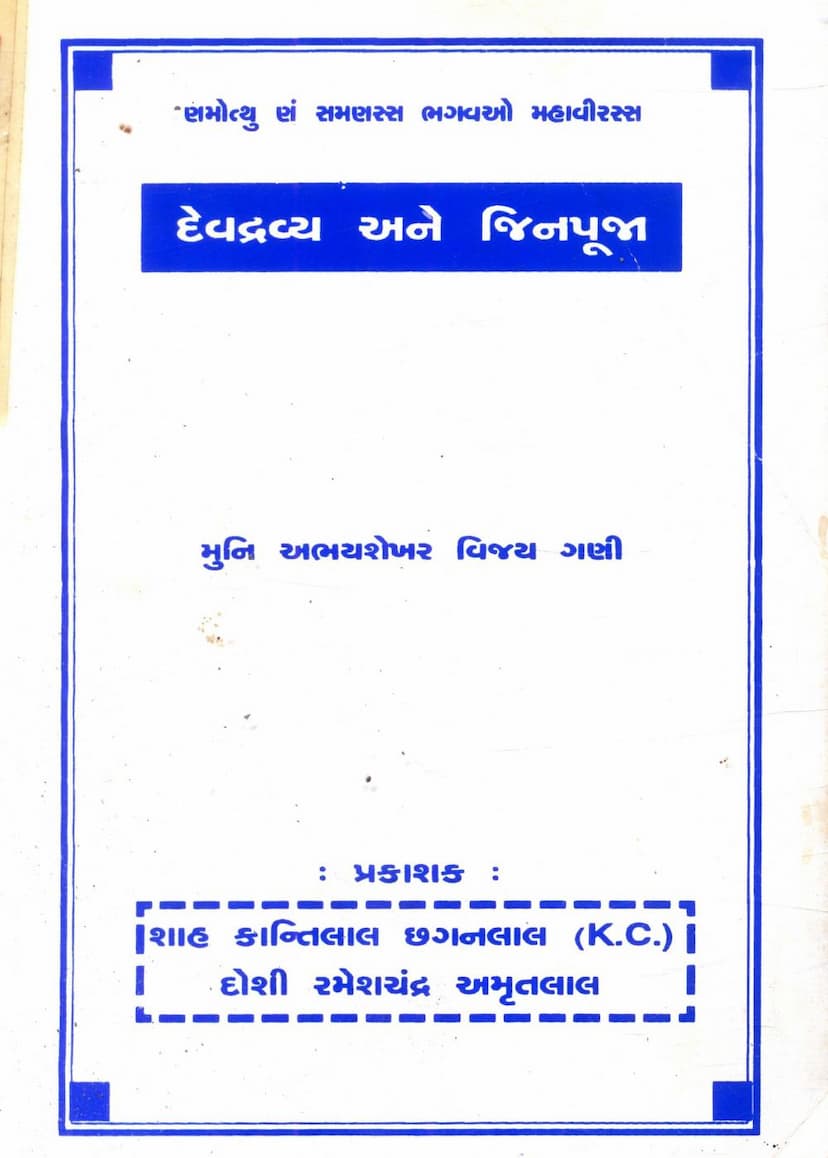Devdravya Ane Jinpuja
Added to library: September 1, 2025

Summary
Here's a comprehensive summary of the Jain text "Devdravya ane Jinpuja" by Muni Abhayshekharsuri, based on the provided pages:
The book "Devdravya ane Jinpuja" (Devotional Wealth and Jin Worship) by Muni Abhayshekharsuri, published by Kantilal Chaganlal and Rameshchandra Amrutlal Doshi, addresses a fundamental question within Jainism: Can Devdravya (wealth dedicated to God) be used for Jinpuja (worship of the Jinas), and does doing so incur the sin of consuming Devdravya?
The central argument of the book, supported by numerous scriptural references and logical reasoning, is that Devdravya can indeed be used for Jinpuja and other religious activities, and this usage does not constitute the sin of consuming Devdravya.
Here's a breakdown of the key points and arguments presented:
1. Scriptural Evidence for Using Devdravya in Puja:
- The text cites passages from various Jain scriptures like Shradhdvidhi, Drvyasaptatika, Shradhdindinkritya, and Dharmasangraha.
- These scriptures explicitly state that Devdravya enables the proper worship, upkeep, and adornment of temples (Chaitya Samarchan, Mahapuja, Satkar).
- A quote from Darshansuddhi Prakaran mentions that through Devdravya, knowledge, faith, and conduct (Gyan-Darshan-Charitra) become radiant through pujas and festivals performed by lay followers.
- Another passage from Drvyasaptatika suggests that wealth like gold (Devdravya) should be used to increase and support activities like temple visits and ritual baths (Jinbimbayatra Snanadi Pravrutti).
2. Refutation of the "Devdravya Bhakshan" (Consuming Devdravya) Argument:
- The author strongly refutes the notion that using Devdravya for puja incurs the sin of consuming Devdravya.
- He points out that Jain scriptures are inherently consistent. If the scriptures permit the use of Devdravya for puja, they cannot simultaneously condemn it by calling it "consumption."
- The author highlights that when challenged to provide scriptural proof for this prohibition, opponents have been unable to do so, resorting to vague claims or propaganda instead of specific scriptural citations with translations.
3. Addressing Counterarguments and Misinterpretations:
- The book directly addresses a common argument that scriptures state puja should be performed with "Swadravya" (one's own wealth) "Yathashakti" (to the best of one's ability).
- The author explains that these passages are often presented out of context or incompletely. The full context often pertains to specific situations for householders, and the intent is not to prohibit the use of other types of wealth for devotional purposes.
- He clarifies that the ideal is indeed to use one's own wealth, but when one's own wealth is insufficient or unavailable, using other legitimate means, including Devdravya, is permissible and encouraged.
4. Hierarchy of Devotional Contribution:
- The book outlines a logical progression:
- Prioritize using one's own wealth (Swadravya).
- If Swadravya is insufficient, contribute to community efforts (Sangh) through tips or donations.
- Only when the above are not feasible, then use Devdravya to fulfill the devotional need.
- However, the author emphasizes that this is a matter of individual duty and aspiration, not a strict prohibition against using Devdravya.
5. Benefits of Using Devdravya for Devotional Activities:
- Enabling Devotion: Devdravya ensures that devotional activities are not hindered due to a lack of personal funds.
- Maintaining Temples and Idols: It is crucial for the upkeep, renovation (Jirnoddhar), and adornment of temples and idols.
- Supporting Priests and Staff: Devdravya can be used to pay adequate salaries to priests and temple staff, preventing potential misconduct or disrespect towards the temple.
- Uplifting Devotional Experience: Using Devdravya can facilitate grander pujas, festivals, and adornments (Angarchana), enhancing the spiritual experience for devotees.
- Preventing Mismanagement: In cases where trustees are unwilling to contribute to other temples or renovations, using their own temple's Devdravya for essential religious activities is better than letting it remain idle or be mismanaged in ventures that cause harm.
6. Addressing the "Bhava" (Mental State) and "Ullasa" (Enthusiasm):
- The text acknowledges that while devotion with one's own wealth might foster greater personal satisfaction, it doesn't mean devotion with other people's wealth (Paradravya) or Devdravya is devoid of merit or enthusiasm.
- Examples are given of how even those who cannot afford to travel for pilgrimage or perform elaborate pujas experience immense joy when assisted by others, demonstrating that enthusiasm and spiritual benefit are not solely tied to personal financial contribution.
7. Addressing Specific Examples and Counter-Explanations:
- The book meticulously analyzes and refutes specific scriptural interpretations presented by the opposing view, particularly regarding passages from Drvyasaptatika.
- It clarifies that restrictions mentioned in some texts are context-specific (e.g., for householder's personal temples) and do not represent a universal prohibition.
- The author defends the use of Devdravya for temple staff salaries, arguing it's not a misuse if it ensures proper temple functioning and prevents disrespect.
8. The Importance of Syaadvaada (Many-sidedness of Truth):
- The author invokes the Jain principle of Syaadvaada to explain how different scriptural statements can appear contradictory but are not when viewed from different perspectives.
- He argues that emphasizing devotion with one's own wealth is a valid perspective (one-sided description – Ekan Deshna), but it doesn't negate the possibility and permissibility of using Devdravya for devotional purposes.
9. A Call for Rationality and Scriptural Accuracy:
- The book concludes with a plea for followers to understand the scriptural basis for the use of Devdravya in worship.
- It criticizes the opposing view for relying on propaganda and misinterpretations rather than clear scriptural evidence.
- The author urges the Jain community to embrace a balanced understanding that allows for the appropriate and beneficial use of Devdravya in maintaining and enriching the practice of Jinpuja.
In essence, "Devdravya ane Jinpuja" is a scholarly defense of the permissibility and even necessity of using Devdravya for various religious purposes within Jainism, aiming to clarify misunderstandings and counter what the author perceives as unfounded prohibitions.